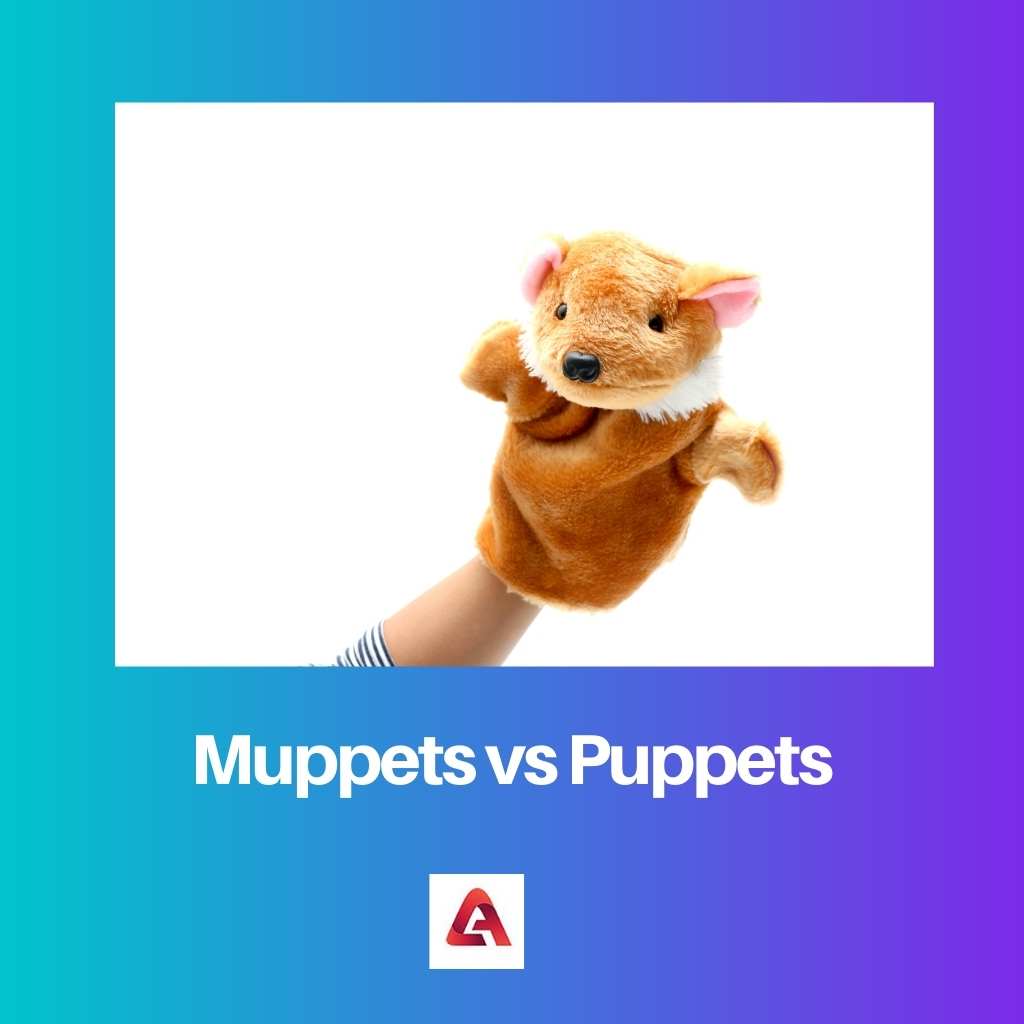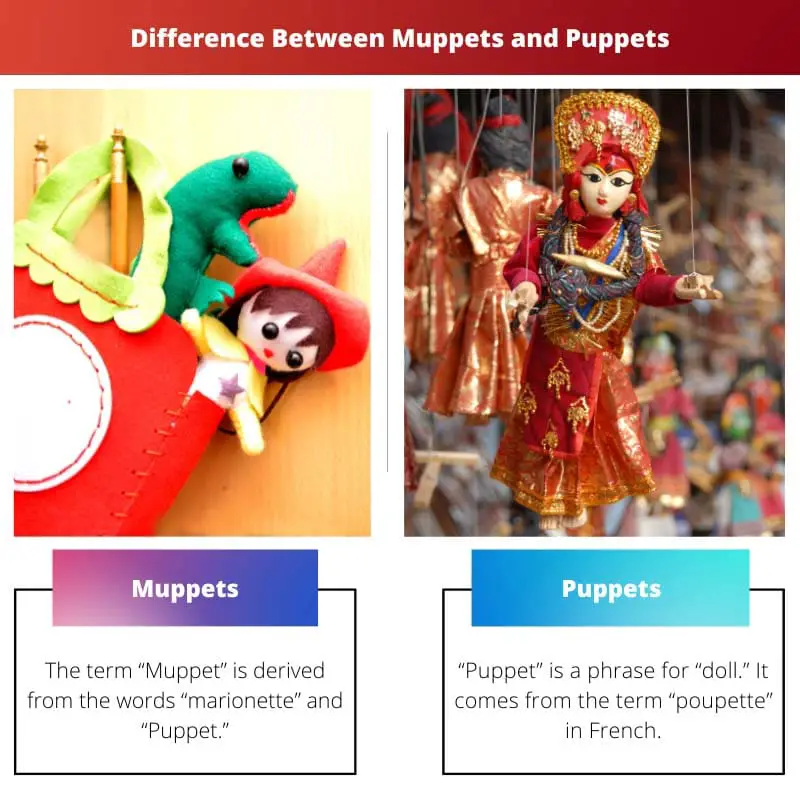Before, in olden times when there was no television, no internet, and no mobiles, people used different forms of entertainment such as storytelling and playing different kinds of sports.
But one of the most fascinating forms of entertainment at that time was Puppet shows. It was trendy among all age groups.
However, a new form of Puppets has been introduced in modern times called Muppets.
Some people do not have a clear idea about Muppets and Puppets; therefore, in this article, we will discuss their differences, characteristics, etc, so that you will have a clear idea about the differences between Muppets and Puppets.
Key Takeaways
- Muppets are specific puppets created by Jim Henson and his company, featuring unique designs, materials, and performance techniques. In contrast, puppets are a broader category of objects or figures manipulated by a performer to create the illusion of life.
- Muppets are characterized by their expressive features, soft construction, and engaging personalities, setting them apart from other puppets.
- Both Muppets and puppets are used for entertainment, storytelling, and education, but Muppets have become iconic characters with a distinct style and cultural legacy.
Muppets vs Puppets
Muppets is a show introduced in 1954. There are three types of puppet shows. Jim Henson created the original muppets. First, he made sketches and then started them. Puppet is a show introduced before the sixteenth century. There are multiple types of puppet shows. Puppets can be of different shapes and sizes.

Jim Henson invented the Muppets, a unique form of a Puppet. The name Muppet, according to Henson, is a mix of the phrases Puppet and Marionette.
Henson was a skilled Puppeteer from the United States. As Muppets, he brought figures like Kermit and Miss Peggy to life.
In Muppets, the fingers and thumbs shape the upper part of the face, and the thumbs form the jaws; these Muppets are well-known for their witty humour.
A Puppeteer creates Puppets that can do various things by manipulating the strings to entertain the spectator. Individuals, especially children, liked and valued Puppet shows in the past when there were few other forms of entertainment.
Large Puppets with humans within are now utilized to regale audiences during celebrations and carnivals
Comparison Table
| Parameters of Comparison | Muppets | Puppets |
|---|---|---|
| Introduced in the year | Between 1954 and 1955 | Before 16th century |
| The word of origin | – Live-hand Muppet – Full-bodied Muppet – Hand rod Muppet | “The term “Muppet” is derived from the words “marionette” and “Puppet.””The term “Muppet” is derived from the words “marionette” and “Puppet.” |
| Type | Foam-based materials, as well as different kinds of materials | – Blacklight Puppet – Bunraku Puppet – Carnival or body Puppet -Finger Puppet – Sock Puppet – Hand or Glove – Human arm Puppet, etc |
| Examples | Miss Piggy, Fozzie Bear, Kermit the Frog, etc | “The term “Muppet” is derived from the words “marionette” and “Puppet.”The term “Muppet” is derived from the words “marionette” and “Puppet.” |
| Made of | Foam-based materials as well as different kinds of materials | Cloth, wood, or plastic |
What are Muppets?
Origin of Muppets: Sam and Friends, a brief television program produced for WRC-TV in Washington, D.C., featured the Muppets in 1955.
The show, created by Henson and his fiancée, Jane Nebel, was the initial type of Puppet media to do away with the traditional proscenium arches and therefore depended on the inherent frame of the T.V. set from which it was seen.
Henson created a variety of personas for these Puppets, each with its name.
Walt Disney currently maintains Muppets, although Jim Hansen utilized them in many films and television series broadcast in various languages around the world.
These amusing individuals and their antics amused people. Walt Disney purchased the rights to make films and T.V. series with the Muppets when Hansen died, and the firm has been producing movies and T.V. series on a commercial basis ever since The Muppets was launched in 2011.
How Muppets are Made: Jim Henson was the single creator of the original Muppets.
Before getting to work on it, he made preliminary sketches of what he imagined the Muppet would look like. Kermit, a lizard-like character, had a cardboard frame wrapped in fabric taken from Henson’s mother’s furry green coat in the initial incarnation. In its eyes, Henson used two halves of the Wacky Stax toy.
The creation of new Muppets starts with sketches and progresses to comprehensive concept designs. When the workshop’s artistic supervisor accepts the concept, a builder makes the Muppet’s head and body.
Most Muppets are manufactured of reticulated polyfoam, which is lightweight, elastic, and long-lasting.

What are Puppets?
Origin of Puppets: It’s fascinating to learn about the history of the Puppet and how it becomes a cultural icon. The earliest Puppets are thought to have been invented in India around 1000 B.C.
Simple stick characters constructed from diverse substances on the ground or elsewhere were likely the earliest Puppets.
‘While the early Puppets were undoubtedly simple in construction and look, the Puppet performances’ were loud and full of commotion. Many societies later produced their Puppet shows, which mirrored the culture in which they were raised. ‘While the early Puppets were undoubtedly simple in construction and look, the Puppet performances’ were loud and full of commotion. Many societies later produced their Puppet shows, which mirrored the culture in which they were raised.
Puppet performances, like tales and legends, became famous as a fun way to spend time with companions and families and were handed down through the centuries.
How Puppets are made: Puppets come in various shapes and sizes, as well as different materials, based on their form and purpose.
They can be built in various ways, from the most complicated to the most basic.
“Finger Puppets, which are little Puppets that fit on a finger, and sock puppets, which are made of a sock and controlled by placing one’s hand into the sock, with the extending and shutting off the hand imitating the motion of the puppet’s “mouth,” are the most basic.”Finger Puppets, which are little Puppets that fit on a finger, and sock puppets, which are made of a sock and controlled by placing one’s hand into the hose, with the extending and shutting off the hand imitating the motion of the Puppet’s “mouth,” are the most basic.
A hand Puppet, sometimes known as a glove Puppet, is operated by one hand, which fills the inner part of Puppet and moves it about.
Many strings and a centre rod coupled to a controlling bar handled from above by the Puppeteer are used to hang and operate Marionettes.
Rod Puppets, on the other hand, are created by attaching a head to a centre rod. A body shape is suspended over the rod, with hands operated by distinct rods. As a result, they have additional movement options than a typical hand or glove Puppet.

Main differences between Muppets and Puppets
1. Muppets are introduced much later after the introduction of Puppets.
2. Only Muppet Studio can use the title Muppets in its films, although Puppets are a common term.
3. Muppet actors manage their characters from behind the scenes, employing live cameras while Puppeteers have been caught on camera at work presenting a Puppet show.
4. Television, films, and the Internet are more closely associated with Muppets than with Puppets.
5. Muppets are characterized by their Puppeteers, whereas, Puppets are characterized by the characters they portray

- https://search.informit.org/doi/pdf/10.3316/ielapa.462547434528433
- https://www.degruyter.com/document/doi/10.1515/comm.1997.22.4.383/html
